
Mindil beach, Darwin, NT.
On arrival in Darwin I pitched my tent between the shade of two trees in the Shady Glen Caravan Park in the Darwin suburb of Winnellie. Being the end of the dry season, there wasn’t much grass left to camp on. Sprinklers ran day and night but they didn’t seem to make all that much difference. The grass just didn’t want to grow in such hot, dry and shady conditions. The daily maximum temperature in Darwin hovers around 34 degrees Centigrade. That may seem a nice comfortable if you’re sitting beside the fire in a northern winter. But it isn’t, as the minimum temperature is around 26 C. Unless you’ve got air-conditioning there is very little relief from the heat. And then there’s the humidity to deal with.
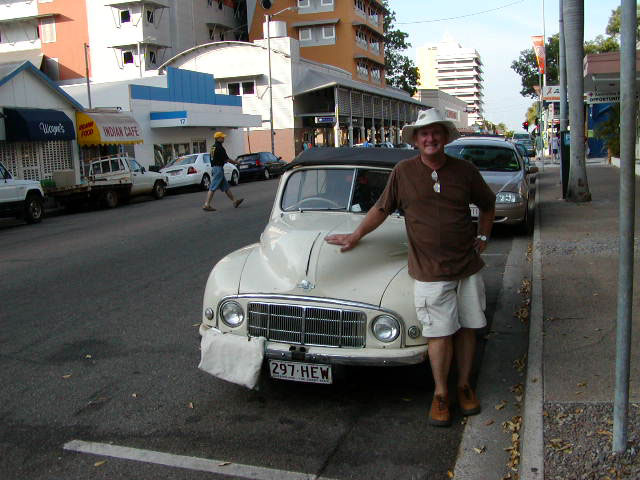
Darwin City, Northern Territory, Australia.
Darwin is on the coast and this naturally brings up thoughts of a tropical shore line, with beaches, coconut palms and cool sea breezes. Far from it, there are beaches in the vicinity of Darwin but they’re also popular with the local crocodiles, poisonous stone fish and during in the monsoon, the notorious box jelly fish. There are many fresh water swimming holes, but these are sometimes inhabited by smaller fresh water crocodiles which aren’t a serious threat. But there’s always the chance that during a high tide or flood, one of the man eating salt water crocs will swim up into a fresh water tributary and sit there and wait for some poor unsuspecting tourist. There is only one place to cool off in Darwin and that is in a chlorinated swimming pool. After pitching my tent, the park’s swimming pool was the first place that I went.
Next day I drove into the City of Darwin. My first visit to Darwin back in 1969, I found a small country town. The city was wiped out in the cyclone in 1973 and rebuilt. My next visit was in 1982, and the town had grown in size and population. But this visit I found a city booming from tourism. It was September. The locals told me that most of the tourists had left in early August but down on the tourist strip it was still business as usual with bars, restaurants, hotels, backpacker resorts, retail stores and internet cafes all still doing a roaring trade. Darwin had changed. Last time I was here I felt like I was one of only a small number of tourists in the town. Now it was full of tourists and tourism now appeared to be the main economy of the city.
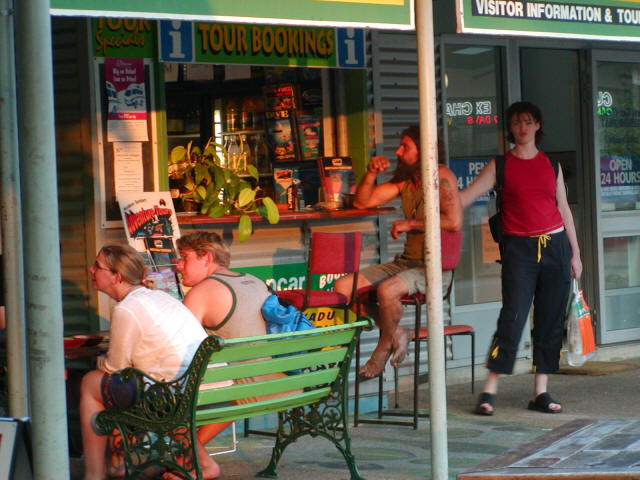
Cafe scene in Darwin, N.T.
I stopped by a local tire dealer and asked about Michelin tires for Hewie. The salesman looked through a pile of catalogues and made a couple of calls, but ended up looking up at me with a defeated look on his face.
“Sorry mate, I can’t help you. I certainly did my best, even called Adelaide but no one seems to have or know where to get them.”
I thanked him for his effort and went out to Hewie and drove down the road a little until I came to another dealer. The same again, but this time the salesman gave me a telephone number of a tire expert in Adelaide.
“Give this guy a call, I just tried but he’s not in” said the salesman.
Somewhat defeated I climbed into Hewie and headed back to the camp ground. When I got back I gave the expert in Adelaide a call but he still wasn’t there. Next morning I called him again but still no luck. I then called the Morris Minor Center in Sydney, luck was with me this time. The owner Allan answered the phone.
“We sure do have tires that’ll fit,. How many do you need?” he said.
“Is your company the only place in the whole country that has tires for Minors?” I asked.
“I know they’re hard to find. Michelin stopped making them about two years ago. For that stretch of time it had become almost impossible to find tires that’d fit. Luckily a company called Nankang in South Korea has started making them. They’re good tires, and priced at one hundred dollars each.”
“I’ll take two. Can you send them up to Darwin for me?” He went then quiet for a minute.
“Yeah sure, I’ll send them to a business called Sports Car World in Yarrawonga, a suburb of Darwin. Can you go out there and pick them up?”
“No problem!”
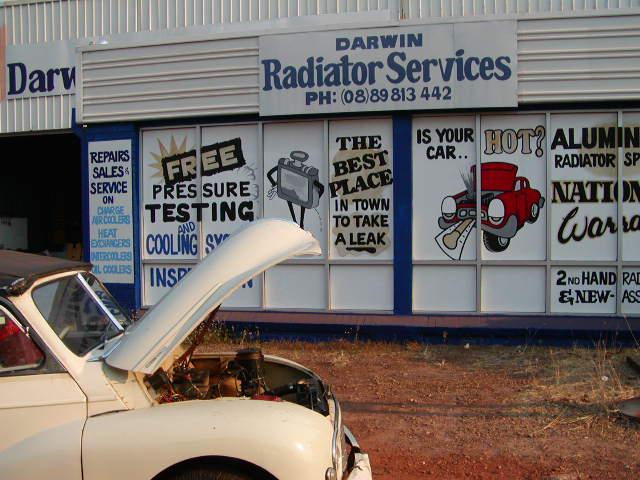
Darwin Radiator Services. "The best place in town to take a leak"
With that problem solved, next morning I took Hewie down to a radiator repair shop. The owner came out and took a few measurements of the old core.
“I’ll send the order off to Adelaide. It should be here in a few days. The damage will be four hundred dollars - that’s if you take the radiator out and re-install it yourself. It’ll be extra if we’ve got to do the lot,” he said.
“Okay then. I’ll give you a call in a couple of days. When it arrives I’ll drop by and take the radiator out, you can fit the new core and I’ll put it back in again,” I said.
I paid him a deposit and a couple of days later returned to the shop, took the radiator out and watched them install the new core. When they finished, I installed it back into Hewie and filled it up with water.
Next morning Hewie failed to start again. Same old problem, - the ignition was working fine and petrol pump was ticking away like new. I left him sit, while I made another cup of coffee. Two other park residents came over and introduced themselves as Jason and Brad from Melbourne, who were in Darwin to fish for barramundi.
“How’s the spark?” Brad asked.
I lifted the lead off a spark plug and out shot a spark about an inch long.
“No worries there! Maybe it’s a fuel blockage in your carby. Why not take the bowl off and wash the plunger in clean petrol.” he suggested.
I got the tool box out and took off the bowl and washed the plunger and needle in some clean petrol and put it back together again. Hewie started first kick. But the problem rose again the next morning. When Hewie just wouldn’t start. Brad and Jason came over again as I opened the hood.
“Same again! Take off the bowl and wash down the needle and plunger. Do you have a fuel filter? Are you sure it isn’t clogged?” Brad said
“There’s a fuel filter in the petrol pump” I said.
I turned off the ignition and pulled off the hose that runs from the pump outlet to the carburetor. I un-bolted the hose connector from the pump and looked in the hole for a small fine wire fuel filter. There wasn’t one.
“Crikey, no wonder you’re having so many problems. The fuel up here in the territory is filthy!”
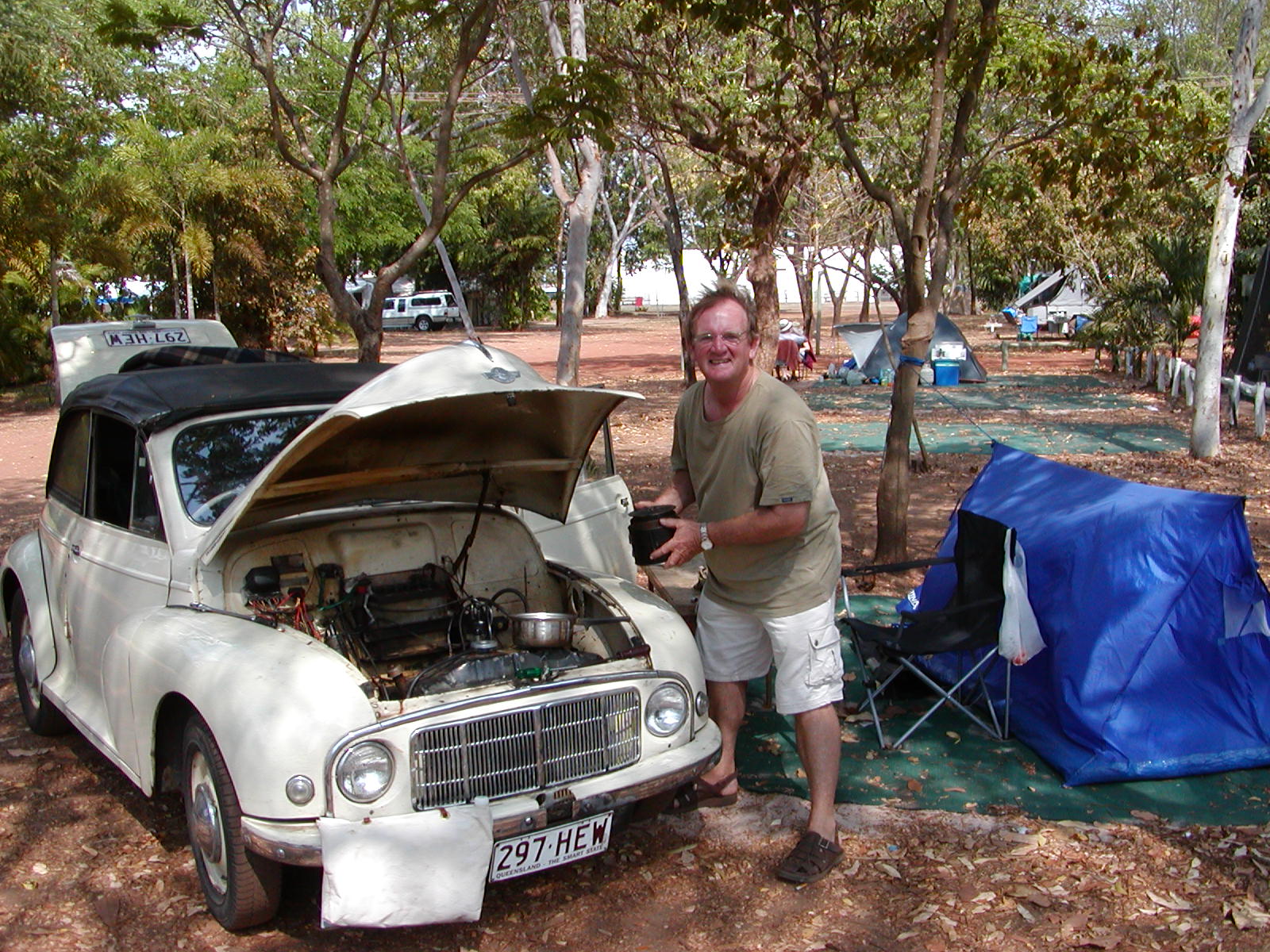
Carby problems in Darwin.
“That’s amazing! When I first bought the car it had an original fuel pump, I can distinctly remember the small fuel filter. Anyhow that pump only lasted a few months after I bought the car. The pump started to overheat and would always cause the car to stop places like traffic lights and one lane bridges, all to the annoyance of other drivers. Get that bloody piece of shit off the road! I can remember some of them yelling out at me. I replaced the original fuel pump with a reconditioned model. That only worked for a short time before I was back getting it replaced. If that wasn’t enough, the second reconditioned unit they gave me also only lasted a few months before it started giving trouble. I replaced that with a brand new one. It has no points in it to burn out like the old models had. That was great I thought, but now I realized that they didn’t include a fuel filter like the originals,” I said.
“Just down the road there’s an auto parts place. They’re only a couple of dollars each. I’ve fitted two to my car,” Brad said.
As we were talking, another park resident came over and joined us with our heads under the bonnet, he introduced himself as Bob from Northam, England.
“I did my time on these things” he said. We all stopped in our tracks and moved aside to let him move in closer and take a look.
“I have some dirt in the carburetor,” I said
“Take off the bowl and we’ll clean it out. Maybe the float is incorrectly set” Bob said. I took the air filter off and took the carburetor apart again. Bob moved in and closely examined it.
“Ah, there’s your problem. You’ve got it set too lean I’ll make a slight adjustment to the float. You’ve been starving it for fuel.”
“I just had the carburetor fully rebuilt before I left,” I said.
“Well they didn’t get this right.”
“Who did you work for in Horsham?” I asked.

Bob, on holidays in Australia from Nottingham, England.
“It was with the Bedford and Austin dealer. I started as an apprentice mechanic. I used to do everything. One my of my favorite jobs was being sent up to London on the steam train to pick up the new Bedford trucks and Austin A40s for the showroom.”
He went back to his camper van and brought back his own tools and made the adjustment to the float level and reassembled the carburetor. I pulled the starter button and Hewie started first turn and idled perfectly. Bob looked and listened to the engine ticking over.
“Who set your tappets? You’d never get away with them being set that loose when I was a mechanic in the workshop. The boss would tell you to go back and set them again,” he said.
“I dunno. A bloke gave me the engine and it looked okay so I put it in. I never thought about setting the tappets. I had too many other things to think about,” I told him.

Jason and his Holden.
Next day I called the Sports Car City to find that the tires had arrived. As I drove down to Yarrawonga, I envisaged a fancy sports car sales yard on a major road. But instead I found a shed on a back street surrounded by old Morris Minors, Oxfords, Minis, MGs and a few other classics. Some were for spares sitting out in the weather and others were in the large shed being restored or in for general repairs. The owner Ben came out and introduced himself and pointed me towards the tires.
“Sorry mate. I can’t fit them for you. You’ll have to go down the road a bit. There’s a tire dealer down there.” He looked at my interstate number plates.
“You come a fair way. How’d she go? No major problems?” he asked.
“The usual, a blown radiator hose, brushes burnt out in the generator, leaky water jacket on the engine. Nothing severe, like a cracked block or a blown piston,” I said.
“Come in for a cup of tea,”
We sat down at a large table among newspapers, tools, spare parts and old tea cups. After tea we moved upstairs to his classic car library and furthered our discussion on classic cars.
I offered to pay him for receiving the tires but he refused and wished me a safe journey. I headed down to a tire dealer a few kilometers away. They jacked the front of the car up and while they were fitting and balancing the tires I got the grease gun out and greased the front suspension.
Hewie was now set for the next leg of the journey, from Darwin to Broome. Next morning the odometer showed17,348 miles on the clock. I subtracted the original mileage and the result was 3,745 since leaving Ballina. I was hoping to get away before sunrise but I was slow at packing up. Furthermore, a new tent sat beside mine. They must have arrived sometime in the night. Just before I was about to leave a woman emerged from the tent and bade me a good morning. She told me how she had just arrived from Perth over the same route that I was planning to take. I had a mile of questions that I hit her with, and she told me how at a place called Victoria Crossing which is about half way between Broom and Darwin, the battery in her new Holden 4WD failed. She went to the local service station who ordered her one to be sent up from Perth. It arrived after a few days but it was the wrong battery and it didn’t fit. So they sent it back and finally sent the right one up. It fitted, but the final cost was $350.
Back on the road again, I gave Darwin a wave goodbye and headed back down to Katherine. Here I planned to make a right hand turn onto the Victoria highway and head west to Broome. The run down to Katherine took a little over 5 hours. On arrival in Katherine I stopped a pub in town called The Diggers for some Barramundi (fish) and chips washed down with an icy cold glass of Victorian Bitter, before heading out to set up camp Katherine Gorge. The temperature was forecast to be a maximum of 37 C in Katherine. But when I pulled into the tourist parking lot at Katherine Gorge it must have been up there in the forties. I changed into my swimmers and headed down for a swim in the gorge. On the way down I passed the beginning of some nature walking tracks. They advised that the maximum temperature on the trails that day was expected to reach 50C. I decided not to do a bushwalk - instead I headed down to the swimming hole. The camp at the gorge, where I stayed the night had to be one of the best I had stayed in on the whole trip. There was lots of wildlife including tame kangaroos which hopped around the park.
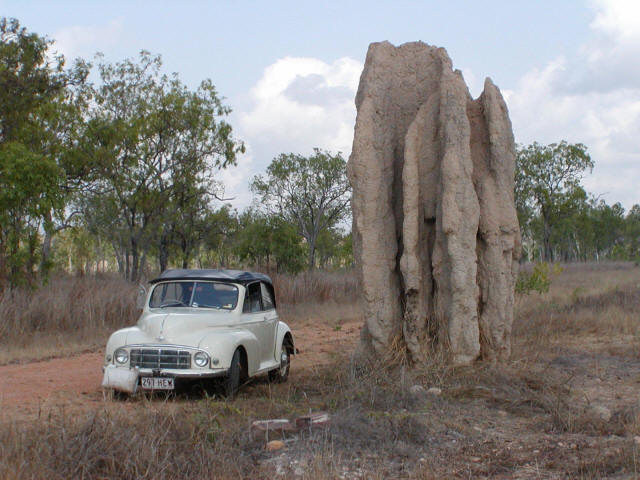
A giant ant hill between Darwin and Katherine in the Northern Territory, Australia.
Next morning was the 1st of October 2004. I drove back into Katherine, filled up with fuel at a cost $AUS1.09 a litre. I headed out onto the Victoria highway and a few kilometers out of town I passed over the bridge crossing the new railway line running from Adelaide through to Darwin. Just off the bridge I passed two hitch hikers with their thumbs out looking for a lift in the same direction. I gave them a wave, If, I’d had more room I’d have picked them up, but my backseat was full and the passenger seat was also covered in odds and ends. I then passed a sign saying “Next fuel stop Victoria River 193 kilometers”
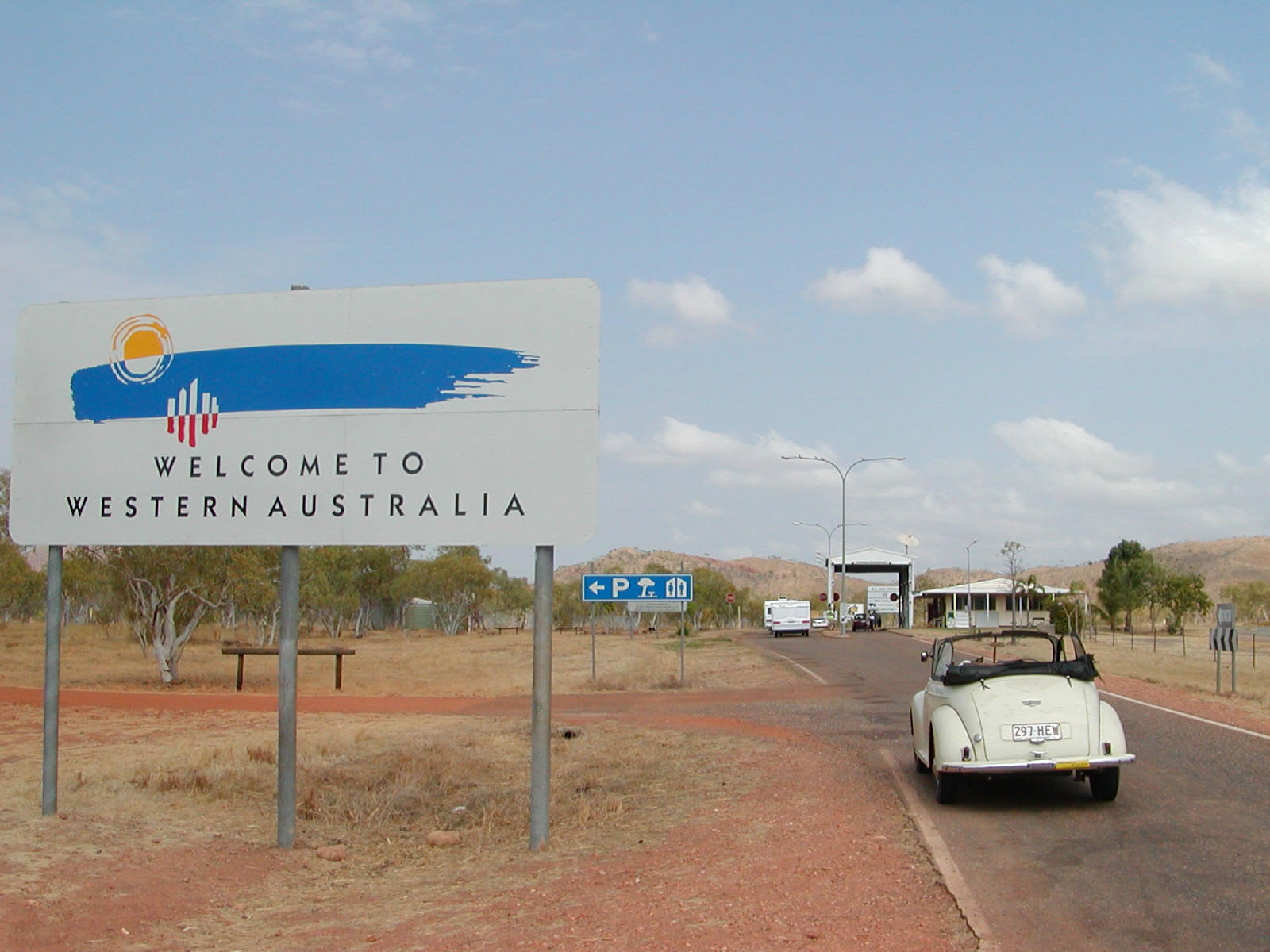
Welcome to Western Australia.
After a three hour drive I crossed over the Victoria River Bridge and pulled into the Victoria River service station and camp ground. That is all there was of Victoria River. I wandered down to the rivers edge where signs warned of crocodiles. I thought of staying in the camp ground but it was hot and dusty so I decided to keep moving. I went back to the restaurant at the service station and sat down to a cheese and tomato sandwich before heading off again to the next town; Timber Creek. When I arrived there and saw the camp ground I was glad I’d kept moving. Where the Victoria River camp ground was a dust bowl, the camp ground at Timber Creek was set on the side of the creek and the ground was covered in cool green grass. I set my tent up in the shade of two trees. The town was made up of a general store, service station and a few houses. A large Aboriginal community was the main population of Timber Creek.
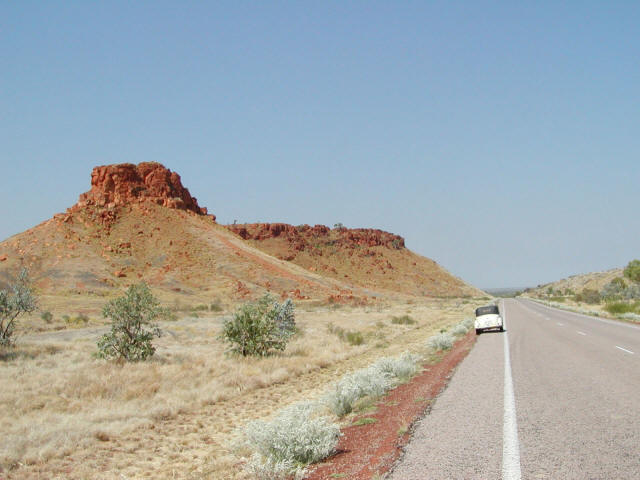
On the road in Western Australia
Petrol at Timber Creek was $1.35 a litre. I filled up, added a little oil and a cup full of water. The new radiator was doing well in the intense heat only using a cup of water since leaving Darwin. Next stop after an easy three hour run from Timber Creek was the Northern Territory and Western Australian border quarantine station. The purpose was to stop bug infected fruit from entering Western Australia. The quarantine agents did a reasonably intensive search of all cars, asking for any fruit, vegetables or even the box or packages that they came in. From here I continued on another 50 kilometers into Kununurra.
An Aboriginal word meaning “meeting place of large waters” Kununurra sells itself to the tourist industry as the eastern gateway to the Kimberly. When the town first started back in the early 1960s, tourists were the last thing on the minds of the original white farmers who came to the area. A large dam, the Diversion dam, was built as part of the Ord River scheme. The water is used to irrigate the local area, where sugar cane and tropical fruits are grown. The town’s population is around 5000 people.
The Town Caravan Park is across the road from the business district. It may not be the most adventurous, but is certainly the most convenient. I was in the process of setting up my tent when a truck carrying a Toyota HiAce van stopped next to the adjoining camp site. The driver of the truck, and a couple jumped out. The driver pulled the ramp out at the back of the truck and slid the van down into the camping space. He spoke to them for a minute or two then climbed back into the cabin and drove off. They both stood there looking at their van in a sad and dejected manner.
“What’s the problem?” I said as I walked over towards them.
“It spluttered and came to a stop after we left for Broome this morning. We couldn’t get her to start again, so we had to get towed in. The truck driver told us that it’s either the petrol pump or ignition. We are worried about how much it’s going to cost to get fixed. I’m Hans and this is Maria”
“You sound like you’re from Germany?” I asked.
“Yeah”
“I wouldn’t worry about the cost in getting it fixed if it’s only an ignition or petrol problem. Those things are easy to fix. Will it start?” I asked. Hans climbed in and turned the key, the engine fired up.
“Sounds okay by me, put your foot on the gas” I ask. The engine then died.
“Maybe it’s your points or condenser” I suggested. Hans opened the engine cover. It was covered in fine red dust. I reached for the distributor and took the cap off. The points looked fine, but where was the condenser? I looked everywhere but couldn’t find it, no doubt hidden under the dashboard or somewhere to keep the backyard mechanic like myself puzzled. Then I looked for the petrol pump and found it, but it was impossible to reach. The only way of getting to it was to jack the car up and climb under.
“I’m reasonably knowledgable when it comes to Morris Minors but these modern cars!” I said. They laughed.
“Don’t worry, a mechanic is coming tomorrow morning. Right now let’s have a cold beer,” Maria said.
“Sounds like a good idea to me. Don’t let the ice melt and let them get warm”
Next morning the mechanic arrived and replaced the petrol pump. The cost came to $230. They were happy and the next day set off again for Broome.
In the tent next to me there was an Italian couple. They also had a Toyota HiAce but it had either cracked the block, blown a head gasket or piston. Whatever was the problem, it had clocked up some serious internal damage with water inside the cylinders. They’d also been towed into town, but didn’t have the money to pay for repairs so had taken a job picking melons. Now, farm labouring would be good if you were born in Kununurra and were used to the heat. They introduced themselves as Christina and Roberto.
“We both got jobs on a fruit farm, just out of town. My job was in the packing shed, Roberto’s job was in the field picking the melons. It was hard work in 40 degree heat. We’d only been working there a few days when we were offered jobs working in the pub. We took them immediately. We have been here a month and will get the van fixed and continue on our around Australia trip in a couple of weeks,” Christina said.
Near our tents was a woman who introduced herself as Sharon from Newcastle. She’d set off in a camper van to find herself again after a divorce and had stopped in Kununurra to work for a while.
“There is plenty of work on the farms here. I worked for a couple of weeks picking mangos, I lost a lot of weight, which was good, but it was hard work. I was offered a job working here at the caravan park and dropped the fruit picking job like a hot potato,” she said.
“I see signs on shop windows asking for farm workers. Down south when you see a job vacancy it’s generally just asking for one person. I notice here they ask for gangs of workers,” I said.
“I think the farmers are finding it very hard to find workers. I’ve heard that backpackers aren’t coming here to find work as much as they did a few years ago. Maybe they have more money in their pockets now,” Sharon said.
“I get the impression that maybe the ones that do work take their stories home and warn their friends – don’t work in Kununurra, the heat is just too intense. Or maybe they all talk about it in the chat rooms and bulletin boards on the internet. News travels fast these days. On top of that I can fully understand the farmers employing people who don’t have a work permit. Imagine if you were a farmer and every morning you stood at your living room window and watched the fruit rot on the trees because you can’t find anyone to pick it” I said.
As we sat and talked, a large black cloud moved over and it started to rain. The heat of the afternoon dissipated into a cool evening. I slept with a sheet over me. I actually felt a little cold. The next day the steely grey sky stayed all day. For one full day it was cool and there was no sun – it was glorious.
My next destination was the old port town of Wyndham, about a two hour drive from Kununurra. The town sits on the edge of the Cambridge Gulf and was first settled in 1884. You can imagine how isolated this area was back in those days and it still feels very isolated even today. But by 1886 the town had become a boom town boasting of six pubs due to the discovery of gold at nearby Halls Creek.
But as fast as the boom came it disappeared and by 1900 the town’s population had dwindled to about 60 people. This town continued to serve the cattle stations in the area. In 1913 the Western Australian government started the construction of a meat works. Construction slowed down during the World War I but was finally finished in 1919. The meat works continued to be the town’s main economy until 1985 when it was closed. Today, cattle are still exported but a new industry has opened – crocodile farming.
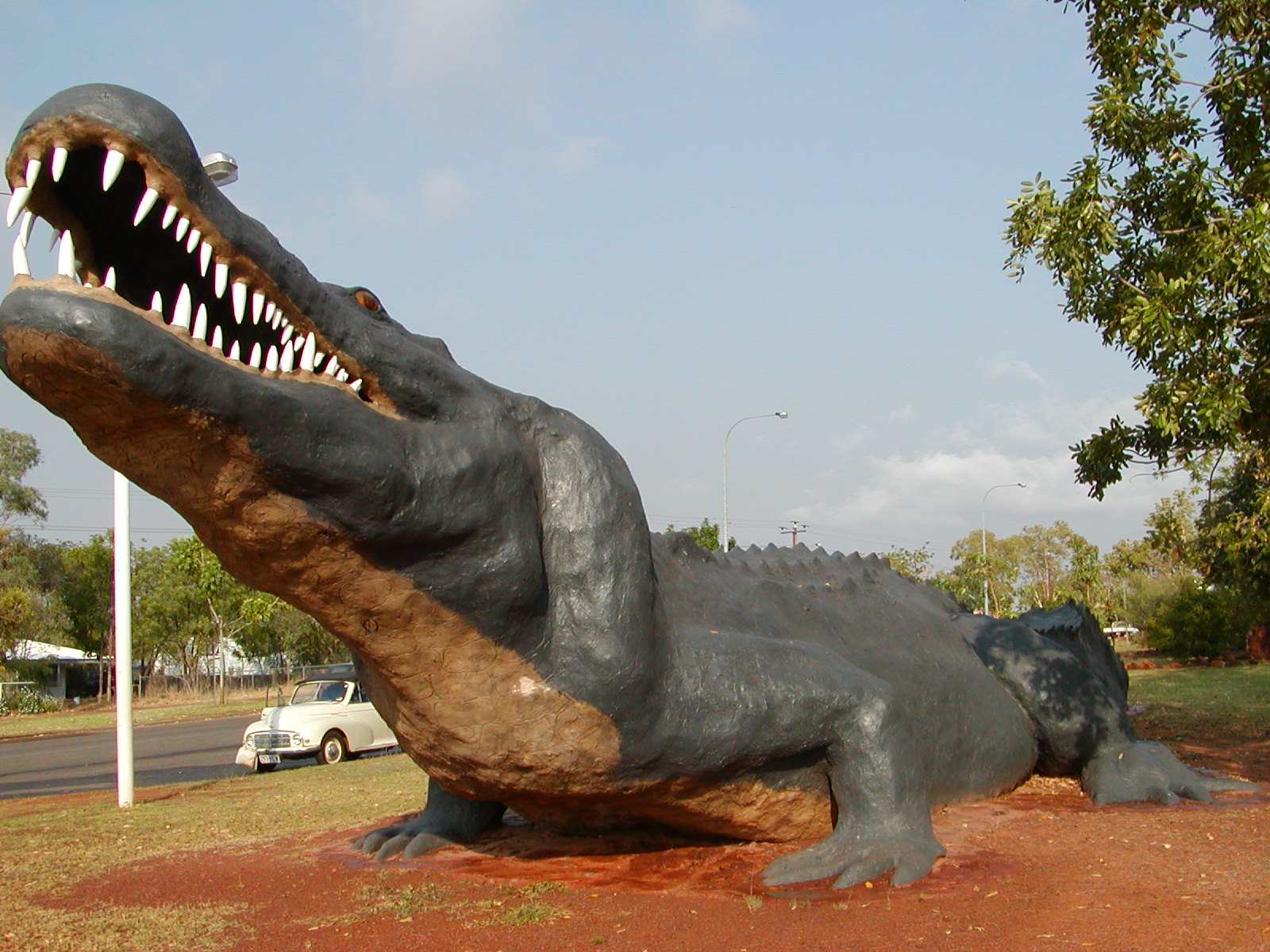
The giant crocodile in Wyndham, Western Australia.
Wyndham is a detour of just over 40 kilometres off the main highway. But it was a town I’d always wanted to visit - its isolation being the big draw card. The town is split into a series of small settlements, like suburbs. The first one I arrived at was called Wyndham Three Mile. Here was a general store, a post office and a large concrete crocodile in a park in the middle of the street. I stopped and took some pictures. I continued on another kilometre to find two service stations, a cake shop and a caravan and camping ground. I then continued on another 4 kilometres down into a small town close to the port. Here I found a series of old shops and a pub on the corner. Across the street from the pub was a museum. All the shops appeared as if they’d closed down years ago. Most were covered in fine dust. Others appeared not to have been painted in years, except for one, a video store which was open for business. I continued on passing a crocodile farm on my way down to the port. Here I looked out over miles of mud flats and mangrove trees that sat there baking in the hot tropical sun. Cattle trucks were unloading cattle onto a ship that sat at the wharf. I stopped by a collection of old railway locomotives and rolling stock that were once used on the short railway that ran between the wharf and the meat works. The one that attracted my attention the most was a single cylinder diesel locomotive.
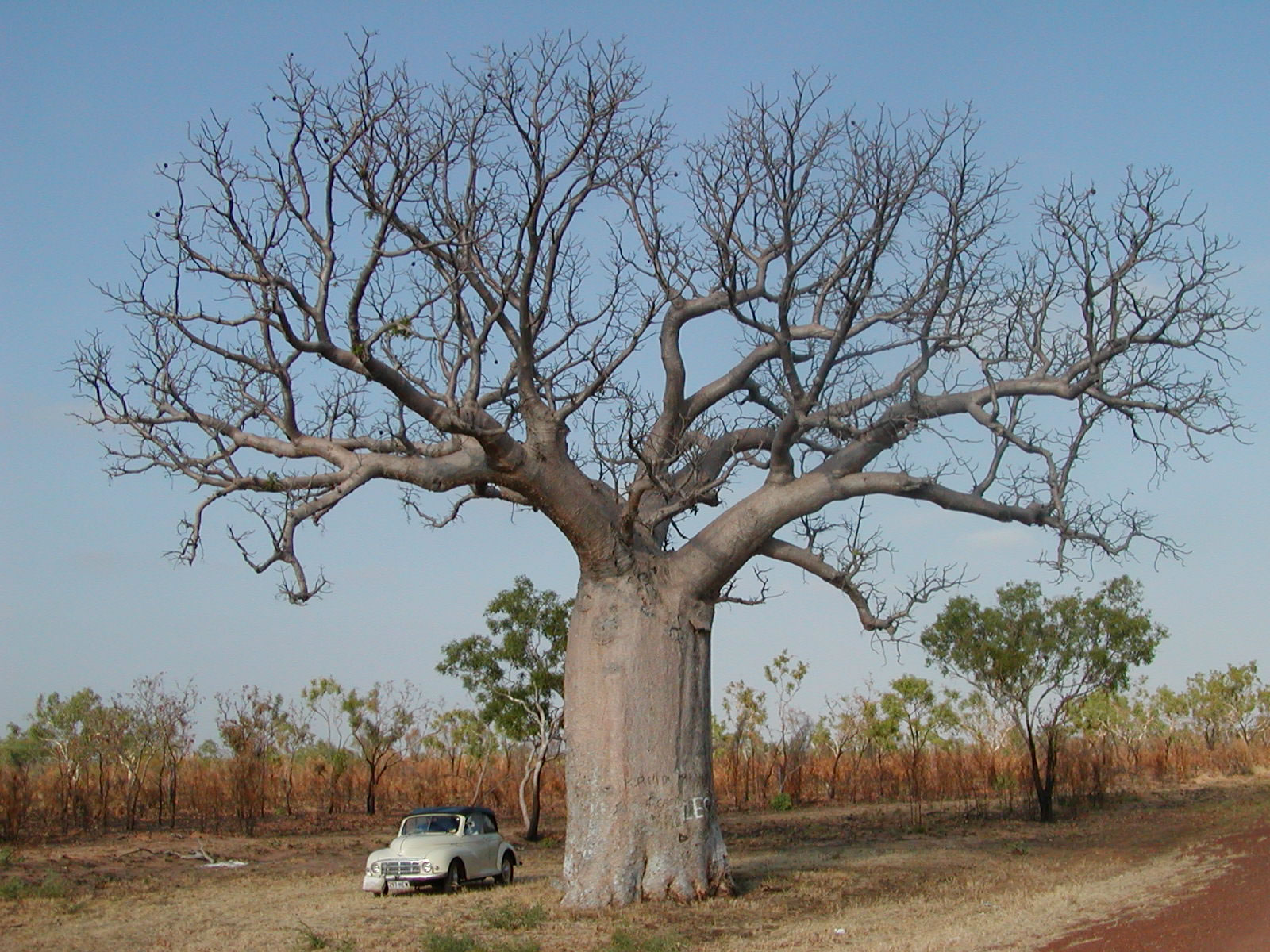
Boab tree
Heading back up into the small town I stopped by the old pub for a barramundi, chips and salad lunch, then headed back along the road to the Three Mile Caravan Park and set up my tent for the night. The park had a camp kitchen. In it was a television, stove and refrigerator. I walked over with a beer to cool down in the freezer. There was another couple with their little boy in the kitchen preparing dinner. They introduced themselves as Jim and Cheryl. Jim worked at the local crocodile farm as a crocodile skinner.
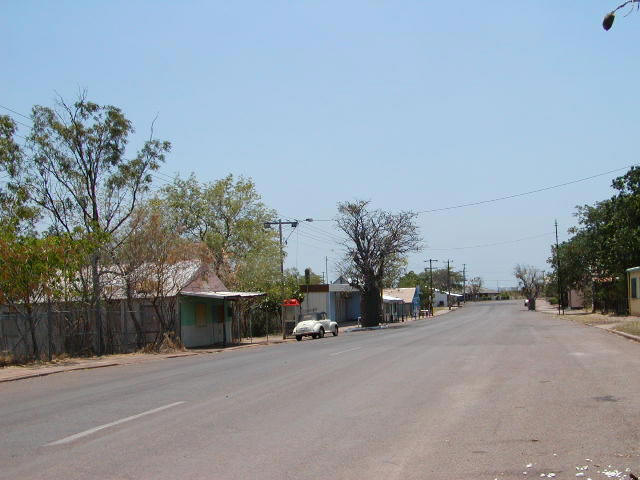
Old shops and a few houses at Wyndham Port, Western Australia.
“How did you learn that trade? Are you a butcher?” I asked.
“No, I’m originally from Darwin. I grew up on a cattle station. Dad, myself and my brother used to go out and choose a young steer, kill and butcher it up ourselves. So I learnt to use a knife as a kid. I originally had a job at the croc farm as just a labourer, feeding the crocs, doing odd jobs and cleaning up around the place. There was a woman there who did the croc skinning, but she wanted to leave so they got her to train me. I’ve been doing it a few years now. I don’t live here in Wyndham I need to move around. I go to a place, skin their crocs and then move on to the next farm. I’m headed to Cairns after I’ve finished here, I’ll head back home to Brisbane” he said.
“Do you earn good money doing it?” I asked.
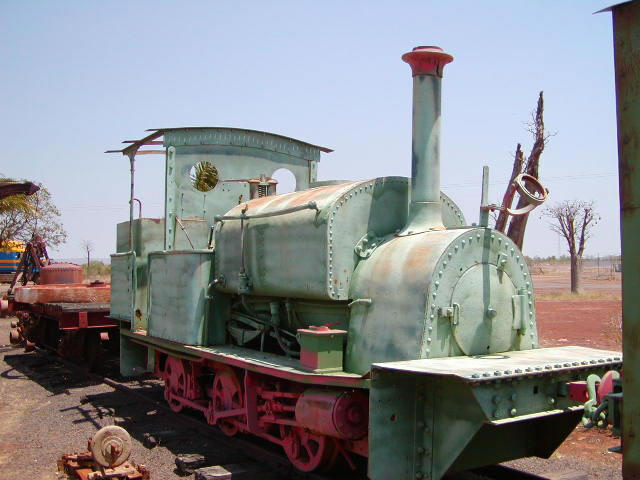
Tank locomotive in Wyndham port, Western Australia
“Sure do, it’s more than a butcher earns, and I didn’t have to do an apprenticeship. It’s much finer work. It’s very easy to slide the knife right through the skin. The part they want is the belly of the croc, it’s softer than a cattle hide. When you’re skinning a croc, you’ve got to careful not to hit the point of the knife in the same spot a second time. Unlike cattle, with a croc, it’ll just go straight through the skin. When the buyers come they look for a nice clean skin with no holes where the knife has accidentally pierced the skin. When I’m finished skinning the croc, I then bone the meat, but that’s not the money maker that the skin is,” he said.
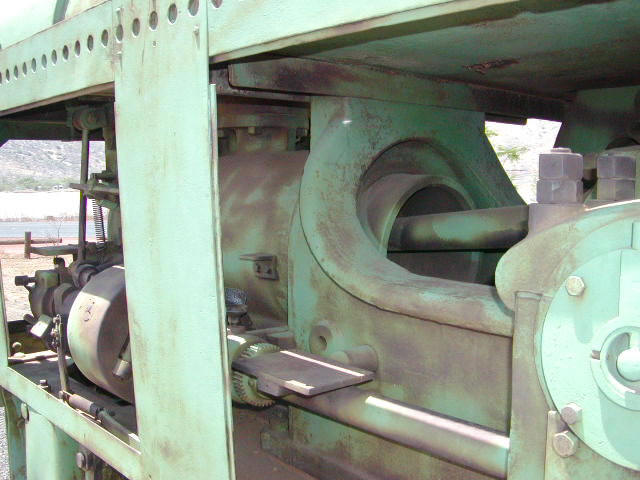
Single cylinder diesel locomotive at Wyndham port, Western Australia.
“I’m not a great lover of croc meat. It doesn’t seem to have any taste and the texture isn’t anything to write home about,” I said.
“I’m not a great lover of it myself, but it’s the skins that count. They go into the making of handbags and belts. In Italy someone is making lounge suites out of croc skin. They sell for a fortune. People keep buying them and they keep coming to us for more skins,” he said.
“How do you both like Wyndham,” I asked.
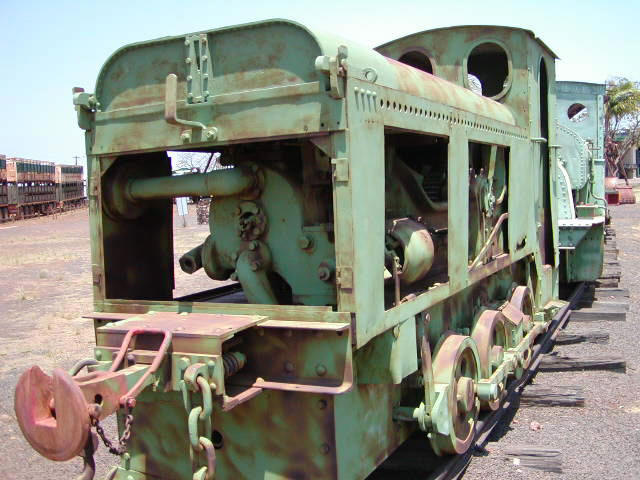
Single cylinder diesel locomotive in Wyndham port. Wyndham, Western Australia.
Cheryl looked at me with a sour look on her face.
“I’d rather Brisbane or Cairns any day. This place is a dump!” she said.
“I kind of like the place. It’s got a strange sort of character about it. Anywhere that isn’t over run with tourists I tend to like,” said Jim.
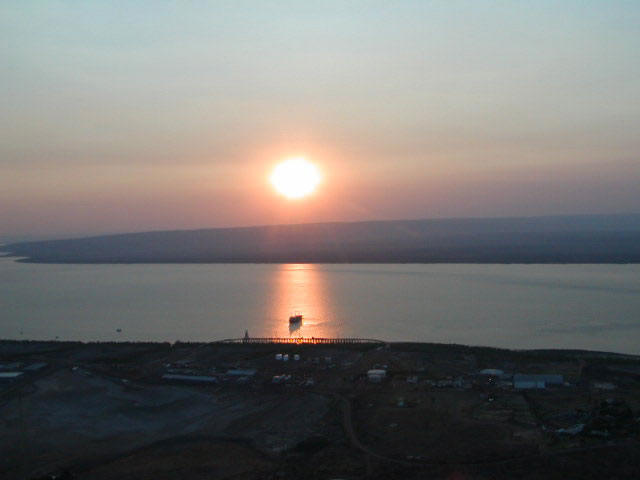
Overlooking Wyndham port. Wyndham, Western Australia.
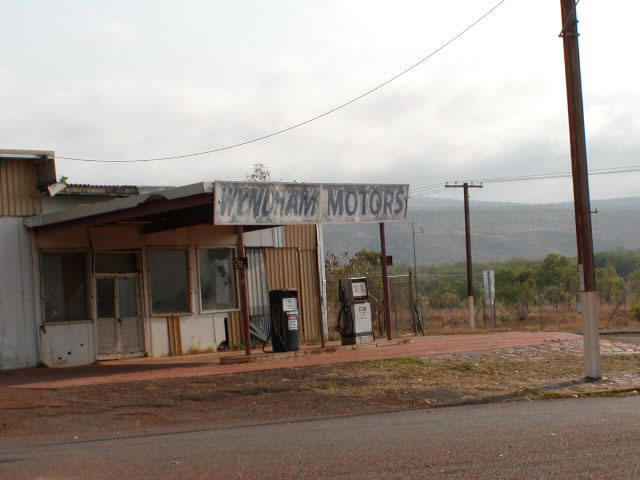
Street scene, Wyndham, Western Australia.
I agreed with Jim. The town had an industrial character, something that disappeared from most small towns back in the 1960s but it was still in Wyndham. There were no boutiques or café’s. Car junk yards were not hidden from sight. Nothing was made to look pretty for visitors. Houses were unpainted and old cars and other pieces of junk normally hidden from sight were all on public display. Not that I would want to live there, but it was a great place to visit – it was different! Now, if you’re reading this, don’t go out and tell everyone what I’ve said. Next time I go there I don’t want to find the place over run with bikini boutiques, condos and alfresco cafés.
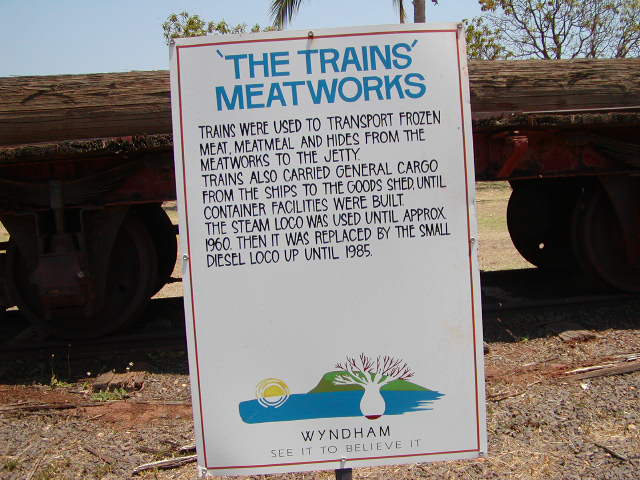
The trains at meatworks info sign in Wyndham. WA
Next morning, before getting on the road, I again I stopped at the service station come wrecking yard, workshop and general store and purchased some petrol. It was $1.17 a litre.
“That’s cheap!” I said to the salesperson behind the counter.
“Where have you just come from?”
“Kununurra. They charge $1.27 a litre for it over there. Why is it cheaper here? I thought you’d be more isolated sop therefore more expensive,” I said.
“Our fuel comes in on a ship from Singapore and from here it’s transported over to Kununurra!”
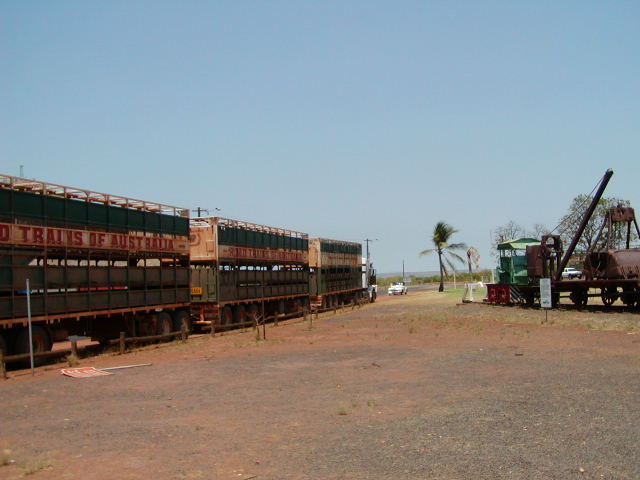
A three "carriage" road train at Wyndham after unloading cattle for export. Wyndham, Western Australia.
My next destination was Halls Creek. After a two hour drive I stopped at a roadhouse at Dunham River. Fuel here had jumped to $1.37 a litre. I pulled up at the petrol pump and was filling up when the whole family who managed the roadhouse came out to inspect Hewie. Their teenage daughter also had a Morris, a 1956 model which was in her grandmother’s garage back in their home town of Toowoomba in Queensland.
“I’d really like to go back to Toowoomba and take it for a drive” she told me.
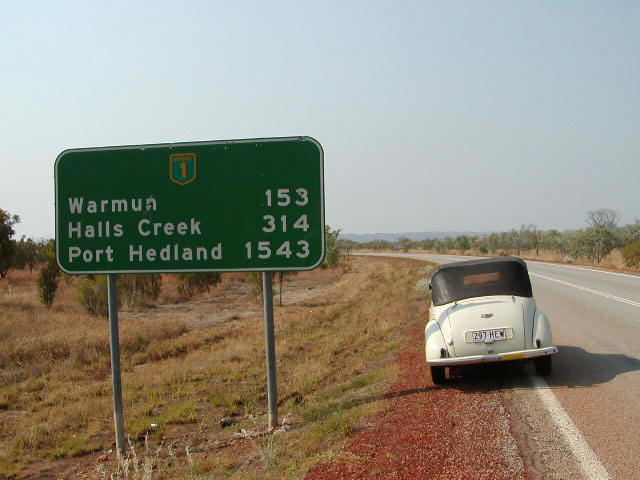
On the road in Western Australia.
The next stop was a roadhouse at Warmun (Turkey Creek). I’d left Wyndham around 7am, which was much later than I had hoped to get away. By the time I got to Turkey Creek it was past midday and getting hot. I stopped and topped up the tank and thought about stopping the night in the camping ground but it was too hot to sit still under the shade of a tree. At least there was a slight relief from the heat with the air rushing past as I drove along. I kept moving. Halls Creek was three hours down the track. After an hour of driving, Hewie started to miss occasionally, then cut out completely for a few seconds then start running again, then cut out and so on. At first I thought it was something electrical. Then I realized it was just a vapour lock. It was so hot that the petrol was probably boiling inside the carburetor bowl. There seemed nothing that I could do to prevent the problem. I just kept driving. Hewie would cut out and start to slow down, then slow down a little more and all of a sudden the motor would start up again. Then he’d start running normally. I’d cover a few more kilometers and then the motor would cut out again and then cut back in when the carburetor cooled enough for the petrol not to boil. A couple of times I pulled over and opened the bonnet to let the engine cool, but it didn’t make any difference. The good news was that the engine wasn’t overheating and not at any time did it look like doing so. The temperature was around 42C and the thermo cycle design was working perfectly, although I wondered what would happen if I needed to climb a long steep hill. I remembered my father saying to me before I left
“What are you going to do when you go up steep hills, it’ll boil,” he said. I remember looking at him and saying.
“This is Australia, there are no hills. Australia is so old that all the hills were eroded away millions of years ago,” I said.
The drive started to become a little stressful. Instead of enjoying the scenery I was constantly listening and waiting for the engine to cut out and wait for it to cut back in again. I assured myself that I’d stick to my plan of leaving before sun up to drive in the coolest part of the day in future.
I stopped off at the caravan park at Halls Creek for the night and set off an hour before sunrise the next morning. The stretch into Fitzroy Crossing was going to be the longest run between petrol stops on the whole trip - a distance of 290 kilometers. The run went well with no vapor locks, taking a little over five hours. The fuel gauge was running well below empty for the last twenty kilometres, but I was reluctant to stop and top up the tank with the 20 liters of fuel I had in a jerry can. Hewie made it into Fitzoy Crossing without requiring the top up.
Two dogs lying in a puddle of cool water under the large awning at the Fitzroy Crossing service station jumped up and ran off when I drove in. I filled the tank, Hewie had used 20 liters to cover the 290 kilometres.
Fitzroy Crossing is now a small mostly Aboriginal settlement. Before there was a suitable bridge to cross the giant Fitzroy River, Fitzroy Crossing was a much larger town. The river consists of just sand flats and small pools of water in the dry season but when the wet season arrives, the river becomes a gigantic floodway. Until the new bridge was built, travellers were often marooned there for weeks on end, waiting for the river to subside. The town is much like Wyndham in that it is series of small communities spread over a large area rather than just one compact little town.
I headed back out of town and stayed at a camp ground next to the river. As I approached the Fitzroy River bridge there was a sign warning of crocodiles in the river. I looked over the bridge and down below were Aboriginal kids waving to me and swimming in the river. The Aboriginals have lived with the crocodiles for millions of years. They even swim with them, but put a white fella anywhere near a river with just the hint of crocodiles and one will for sure jump out and grab him. I’ve never heard of an Aboriginal being attacked by a crocodile. Back at the camp ground there was a swimming pool in which I spent the afternoon.
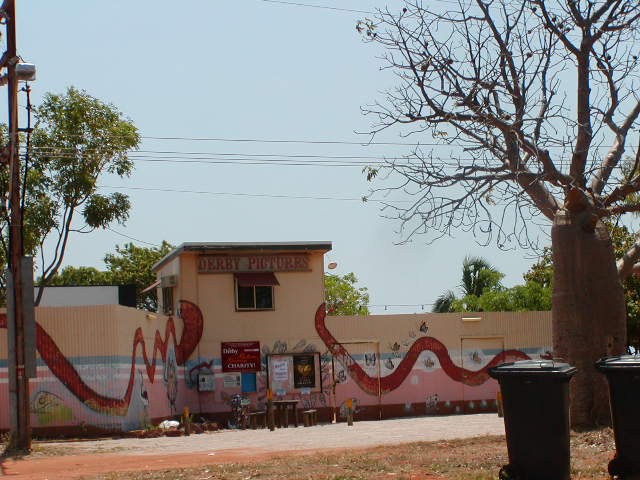
Derby Pictures, Derby, Western Australia.
I rolled out of the tent just before 5am the next morning and set off for the five hour drive into the town of Derby where I stayed the night. Like Wyndham, Derby is also spread out with no real main street. There was a small shopping centre as I drove in and few kilometres further on was another shopping center. Further on were the Council Chambers and library. As I passed these buildings I sighted a white Morris 1000 sitting out front. I swung a quick left and drove into the Derby Council parking lot and parked next to it. I hadn’t turned off the motor, when out rushed a woman from the council chambers and introduced herself as Kaye. She was ecstatic that another Morris had arrived in town and was in disbelief that I’d driven mine all the way over from the east coast. Her and her husband had recently moved up from Perth but they’d had her Morris shipped up on a truck.

Another Morris Minor owner in Derby Western Australia.
“So it is possible to drive a Morris all that way. I’ve only ever used mine to drive a few kilometres each way to work and around the corner to the local shop. I’ve always wondered how she’d go on a long trip. I’ve often thought of driving her down to Broome. Now that I’ve seen you come all the way from Ballina in New South Wales – I’m going to do it!” she said.
“Just make sure your ignition points and spark plugs are in good condition, set out early in the morning to miss the hottest part of the day and drive along at about 60 to 70 kilometres per hour and you shouldn’t have any problems,” I told her.
“Before we left Perth I was nearly in the mind to sell her and buy a car more suitable for up here but I couldn’t, so I brought her along. I’m glad I did, I love her.” she said.
“Nope, once you buy a Morris you really need to keep it for the rest of your life. It’ll become like a noose around your neck, but, you can’t sell them. They become a part of your soul. Sell her and you’ll feel like you’ve sold someone in your family. How many people walk up to you in the street and tell you affectionately that they once owned a Morris the same as yours and wished they’d never sold it.
“You’re right. Lots of people,” she said.
I took some pictures with my digital camera, which I later emailed to her a copy.
Next morning I set off early and arrived in Broome a little after 10.30 am after a five hour drive.
